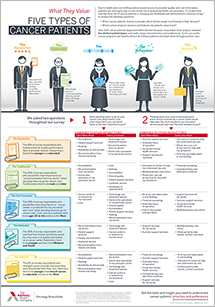Auto logout in seconds.
Continue LogoutWhen author Jennifer Weiner was told she had breast cancer, she immediately "went into panic mode," but subsequent clarification on her diagnosis brought home growing concerns about early detection—and underscored the necessity of accepting ambiguity when science can't provide "Magic 8-Ball-level absolutes."
May 29: Join us for our webconference on oncology innovations
Jennifer's story
Weiner writes that, during a mammogram, her doctors told her they saw a spot in her breast that was concerning, which led her to get a core needle biopsy. She later received a phone call from her radiologist who informed her that her biopsy had come back "'positive for cancer.'"
"I hung up the phone and went into panic mode," Weiner writes, calling contacts and friends to find a surgeon to treat her cancer. After reviewing the films, the surgeon delivered some "good news," Weiner writes: The surgeon said that Weiner had lobular carcinoma in situ (LCIS), which "is not cancer, exactly. It's more like a warning sign for cancer."
While Weiner didn't quite have cancer, the surgeon did tell her that her LCIS was aggressive and that it should be removed. Ten days later, Weiner had surgery, and two days after that, she was informed that she was cancer free.
What this experience taught her about overdiagnosis
Initially, Weiner writes, she thought that her experience with cancer would make her a champion for getting mammograms, always believing that early detection could save lives. However, many researchers are rethinking early detection, Weiner writes.
For instance, she notes that H. Gilbert Welch, author of the book "Overdiagnosed," has said that the practice of "looking for trouble" with increasingly advanced tests and machines means that it's more likely some kind of cancer will be found. The problem is that aggressive treatment isn't always the right course of action for cancers in the early stages.
And while Welch acknowledged that fewer women are dying of breast cancer now than they did in the past, he credits that to better treatment rather than screenings, Weiner writes. Rather, Welch recommends women with early breast cancer be treated similarly to men with low-risk prostate cancer who are told to "watch and wait instead of jumping immediately to surgery." It would take time to shift the paradigm, Welch said, "But maybe the best approach to health isn't constantly looking for things to be wrong."
Similarly, Steven Katz, a professor of medicine and health management policy at the University of Michigan, said he understands why patients want to take immediate action after hearing that they have cancer. "Our intuitive and emotional reactions are wired for millennia and millennia," he said. "When there's a fire in the cave, you run."
That's why Katz emphasizes the importance of what doctors tell their patients. "The way we frame illness and the treatment options is the most important factor driving what happens next," he said. "And the cancer label is particularly profound."
Katz said it's also important for women to get a second opinion. According to a study by Katz and colleagues, over 90% of patients with newly diagnosed, early stage breast cancer don't look for a second opinion. Weiner recalls, "Doctors, [Katz] said, need more training in addressing patients' intuitions. Patients need to slow down and try to keep their emotions in check."
Ultimately, Weiner writes that she doesn't regret her decision to have surgery on her cancer, but she does have questions about the decision-making process. "Humans crave certainty," she writes, and "when we turn to science, we want Magic 8-Ball-level absolutes: Without a doubt. You may rely on it. It is decidedly so"—but sometimes all you get is, "Reply hazy. Ask again later. Better not to tell you now" (Weiner, New York Times, 5/11).
May 29 webconference: Learn the newest clinical innovations in oncology today
Learn about new innovations in radiation oncology and how to position your program for success by revamping your investment strategy, finding opportunities to reduce costs, and prioritizing patient preferences.
Don't miss out on the latest Advisory Board insights
Create your free account to access 1 resource, including the latest research and webinars.
Want access without creating an account?
You have 1 free members-only resource remaining this month.
1 free members-only resources remaining
1 free members-only resources remaining
You've reached your limit of free insights
Become a member to access all of Advisory Board's resources, events, and experts
Never miss out on the latest innovative health care content tailored to you.
Benefits include:
You've reached your limit of free insights
Become a member to access all of Advisory Board's resources, events, and experts
Never miss out on the latest innovative health care content tailored to you.
Benefits include:
This content is available through your Curated Research partnership with Advisory Board. Click on ‘view this resource’ to read the full piece
Email ask@advisory.com to learn more
Click on ‘Become a Member’ to learn about the benefits of a Full-Access partnership with Advisory Board
Never miss out on the latest innovative health care content tailored to you.
Benefits Include:
This is for members only. Learn more.
Click on ‘Become a Member’ to learn about the benefits of a Full-Access partnership with Advisory Board
Never miss out on the latest innovative health care content tailored to you.

